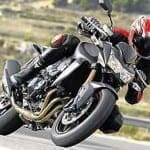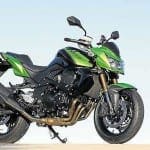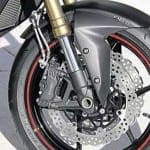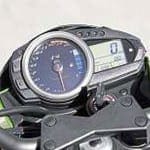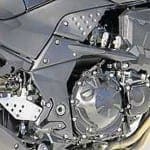The Z750R concept makes perfect sense. After all, the standard Z750 has been a hit since its launch in 2004, with more than125,000 units sold in Europe alone. But since Kawasaki detuned and softened the Zed four years ago to make it more rider-friendly, it’s been a bit dull. A two-wheeled sheep in wolf’s clothing: capable but not as exciting as it looked.
What’s changed?
What could be more logical than an R for- racy version of the Z750, combining sharper styling with improved chassis parts? Especially if it didn’t cost too much extra, because a keen price has always been a key factor in the naked four’s appeal. The R-model certainly seems to tick most of the necessary boxes even though there’s no change to the 16-valve powerplant, whose claimed max output remains 105bhp at 10,500rpm—matching the figures of Triumph’s Street Triple R and Yamaha’s FZ8.
Kawasaki didn’t need to do much to the styling because the Zed already looked cool, its chiselled features doing much to explain the model’s especially strong following in style-conscious Italy and France. Even so, the Z750R was given a facelift, based on a reworked bikini fairing and smoked screen. Along with matt black or two-tone metallic green and gloss black paintwork it also gets new mini-indicators and supersport style solid aluminium footrests.
New chassis parts are the main attraction. Its 41mm USD forks are borrowed from the 2009 model Z1000, complete with rebound damping and preload adjustment on both legs. The shock is alsonew, with remote reservoir as well as a revised action from the revised swingarm linkage. The swingarm itself is based on that of the previous Z1000 and made from aluminium instead of the standard Z750’s steel. Front brake is uprated from two-pot calipers to radial four-piston Nissins, biting thicker 300mm wavy discs. There are braided steel lines all round, plus a new radial front master cylinder.
What’s it like on the road?
The spec sheet looked good, as did the line of Z750Rs glinting in the sunshine outside the launch base hotel at Alicante in south-eastern Spain. Heading off on minor roads and round a few roundabouts, the Zed felt fairly lively and agile. But it wasn’t over endowed with grunt, needing 6000rpm on the tacho before coming alive. At least the motor stayed pretty smooth from there to the 12,000rpm redline. Predictably the Z750R felt sportier than the standard model, especially once we’d headed inland and onto the hilly, twistier roads of the Sierra Marina.
The bike is set up quite firm, and it kept up a respectably quick pace with no drama, staying more stable and controllable than I recall the standard model feeling when ridden on these same roads on its launch four years ago. But if the R-bike went round corners better than the original, it didn’t provide the ‘true super-sport handling’ promised by Kawasaki’s advertising. One reason is weight. Despite shedding 3kg it still scales 227kg wet (roughly 200kg dry), 16kg heavier than the FZ8 and almost 40kg up on the Street Triple R. So although the new front end felt good and the bike steered with a neutral feel, it wasn’t particularly flickable.
The other problem was that the shock felt a bit harsh, conspiring with the thinly padded seat to pass road bumps straight to my own rear end. Adjustment wasn’t easy, even when a C-spanner was eventually located. Restoring preload to the standard setting gave a slightly plusher ride, but the shock is adjustable only for rebound damping, so there was little scope for improvement. Such penny-pinching seems strange on a bike whose main attraction is an uprated chassis.
At least the new front brake gave more power than the standard model’s stopper, along with a decent helping of feel, although it’s a shame the UK bikes don’t get at least the option of the excellent ABS system that’s available elsewhere. There was plenty of ground clearance, though this was partly because the Dunlop D210 tyres seemed a bit short of grip, being particularly prone to squirming on white lines and overbanding.
On a short stretch of A70 motorway, the 750R cruised effortlessly at 85mph – plenty fast enough for my neck muscles, given the lack of wind protection. With my head down and bum on the pillion seat it howled briefly to an indicated 135mph, with a few mph more to come. I had no problems with the six-speed box, unlike a couple of riders who complained of missed changes in the lower gears.
In other respects the Z750R did a good job. Its unchanged riding position is roomy; instruments, mirrors and switchgear are fine; finish seemed good although the scruffy exhaust downpipes don’t match the otherwise cool looks. At £7140 (with 20% VAT from January) the price is reasonable, too: the R-bike costs £510 more than the standard Z750, is slightly cheaper than the Street Triple R and a fair bit less than the FZ8.
Given the success of the standard Zed, it’s easy to envisage the R-model also selling well. Kawasaki has targeted the right areas with its new features. But this model is supposed to beaZ750 with a trick chassis, yet while riding it I couldn’t shake the nagging feeling that it needed less weight and better suspension. So, a decent bike but less exciting than it looks. I think we’ve
Tech spec
Price: £7140 (£6999 to end of December)
Engine: 748cc, fuel-injected six-speed liquidcooled transverse four with four valves per cylinder
Power (claimed): 105bhp@10,500rpm
Torque (claimed): 57.53lb-ft@8300rpm
Bore x stroke: 68.4 x 50.9mm
Rake and trail: 24.5º/103mm
Chassis: Steel spine with aluminium side pieces
Wheels/tyres: Front – 120/70 x 17in Dunlop Sportmax D210 on cast aluminium rim. Rear – 180/55 x 17in Dunlop Sportmax D210 on cast aluminium rim
Suspension: Front – 41mm Showa upside-down telescopic,120mm travel, adjustments for preload and rebound damping. Rear – Showa shock, 134mm wheel travel, adjustments for preload and rebound damping
Brakes: Front – 2x four-piston Nissin radial calipers,300mm petal discs. Rear – single-piston Nissin caliper, 250mm disc
Wheelbase: 1440mm
Seat height: 815mm
Fuel capacity: 18.5 litres
Wet weight (claimed): 224kg (227kg ABS)
Green/black, black
Words: Roland Brown Pics: Double Red, Wout Meppelink




